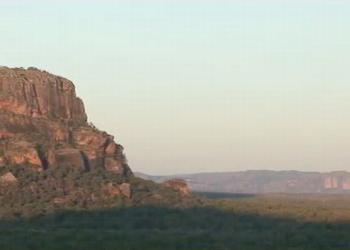
CANBERRA, Australia, February 7, 2013 (ENS) – After 34 years of campaigning to keep uranium mining out of his ancestral land of Koongarra, Djok Senior Traditional Owner Jeffrey Lee sat in the House of Representatives Wednesday to watch this land be protected forever.
Environment Minister Tony Burke introduced a bill to repeal the Koongarra Project Area Act – a 1979 law excluding Koongarra from the original boundaries of Kakadu National Park because of its potential to be the site for a uranium mine.

“In 2010, the Government promised Mr. Lee that we would incorporate Koongarra into Kakadu National Park, to ensure that the threat of mining was banished forever,” Burke said.
Koongarra is an area of native woodland of great environmental and cultural significance, now incorporated within the boundaries of Kakadu National Park. Kakadu is located within the Alligator Rivers Region of the Northern Territory of Australia, 171 kilometers southeast of the territorial capital, Darwin.
The Koongarra uranium deposit is estimated at about 14,000 tonnes. Mining companies, most recently the French company AREVA, have been trying to mine the deposit for decades despite the opposition of traditional owners.
Through the Northern Land Council, Lee stated his wish that the land be included in Kakadu National Park, and that as a consequence, he has waived his interest in Koongarra as a mining lease.
The Gillard Government worked with Lee to secure UNESCO World Heritage recognition for Koongarra in 2011, and since then with the Northern Land Council to finalize the legal steps to make Koongarra part of Kakadu National Park.
“This Labor Government continues the legacy of previous Labor Governments of preserving and protecting the environment for future generations. It was Bob Hawke’s Government in the 1980s that protected Coronation Hill and recognised that this spectacular natural and spiritual environment is no place for mining,” Burke said.
“The decision of Jeffrey Lee means that finally the progress made by the Hawke Government is concluded and Kakadu National Park will be complete,” said Burke. “We are proud to honour the wishes of the land’s traditional owners and to protect one of Australia’s most magnificent national parks for our children and grandchildren.”
Koongarra lies in the shadow of Nourlangie Rock, one of Kakadu’s most popular visitor destinations, with rock art galleries that bear witness to the close relationship Aboriginal people have with their land and spiritual heritage.
On its other side, Koongarra faces Lightning Dreaming, home of Namarrgon or Lightning Man, the creation ancestor responsible for the dramatic electrical storms on the Arnhem plateau.
“The Koongarra lands are not only of enormous significance to Jeffrey Lee and to other traditional owners – but international and Australian visitors would be horrified if mining were to occur within sight of Kakadu’s magnificent rock art galleries and stunning bush walks at Nourlangie Rock,” said Burke. “The exclusion of Koongarra has meant there has always been a hole in the heart of the boundaries of Kakadu.”

(Photo courtesy Government of Australia)
Lee said, “This is a great day for me, my country and my culture. My mind is at peace now that I know that there will be no mining at Koongarra and that Djok lands will be protected forever in Kakadu National Park.”
“My mothers and grandmothers who taught me about the plants and animals, my uncles and aunties who shared their knowledge, to all the elders and my creation ancestors – I give my humble respect for standing here today,” he said.
“I have said no to uranium mining at Koongarra because I believe that the land and my cultural beliefs are more important than mining and money. Money comes and goes, but the land is always here, it always stays if we look after it and it will look after us,” he said.
Lee thanked his supporters and said, “I sincerely thank the UNESCO World Heritage Committee for respecting the values of my country and culture and to the Australian and Northern Territory governments for supporting the inclusion of the Koongarra area into Kakadu National Park.”
“This has been a very long and difficult struggle for me. I have gone through a lot of trouble and heartache and waited a long time to see this day. However, the fact that I am here today proves that if you are true to your culture and to your land one day you will win,” Lee said.
Uranium mining has long been a source of conflict in Kakadu with traditional owners leading campaigns against mining proposals at Koongarra and Jabiluka.
“For years Jeffrey has wanted an end to the push for uranium mining on his country. He has taken his message from the corridors of Canberra to UNESCO headquarters in Paris and consistently called for the protection of his country. This legislation is a welcome acknowledgement of Jeffrey Lee’s efforts,” said Australian Conservation Foundation nuclear free campaigner Dave Sweeney.
Sweeney said, “Uranium mining in Kakadu continues to generate headlines and heartache with mining company Energy Resources of Australia seeking federal approval to develop a controversial underground uranium mine at its existing Ranger site.”
Now, Koongarra is safe from uranium mining.
“I’m pleased to announce that the Koongarra area has now been added to the park lease and will soon be formally proclaimed part of Kakadu National Park,” said Minister Burke.
“Koongarra will then have the full protection of the Environment Protection and Biodiversity and Conservation Act 1999 and as part of Kakadu, uranium mining will be prohibited forever.”
Copyright Environment News Service (ENS) 2013. All rights reserved.
